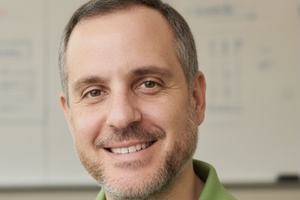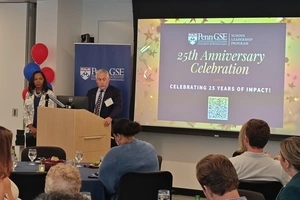These fraudulent messages do not reflect the values of Penn or Penn GSE. We sincerely apologize for the harm and distress these emails have caused and appreciate your understanding as we work quickly to resolve the issue.
In 2022, Penn formalized its partnership with the Henry C. Lea School in West Philadelphia, building on a more than 50-year relationship between the University and the school. The partnership provides both financial support for Lea—$4 million over five years, which has made possible, among other things, the hiring of additional teachers to keep class sizes low—as well as direct services for students and teachers.
Last year, the partnership got a critical new member when the Lea School hired Julia Snyder as its new principal. Snyder, who has lived in the school’s neighborhood for the last 20 years, isn’t just a dedicated and experienced educator-leader, she’s also a longstanding member of both Lea’s local community and the Penn GSE community. (She earned her master’s degree in teaching, learning, and curriculum from GSE in 2010.)
“I was very interested in being a community-based principal,” said Snyder. “I can walk to work. I already knew a number of families because I live in the community. I already felt connected to the school before I became principal.”
As her second year at Lea’s helm began, we spoke with Snyder about some of her school’s recent improvements, the importance of community responsiveness, and her plans for Lea’s future.
Q: Can you tell us about some of Lea’s recent wins?
JS: A big win was we got our preliminary data for the PSSAs. We had a 3.1% gain in reading, and we had a 2.5% gain in math. Those are preliminary numbers, and that's proficiency at benchmark. When I look at numbers like that it means, to me, that we are, in some ways, really hitting the mark of all students making the progress that we want them to make. In fact, we are meeting the majority of our goals, from statewide testing to student attendance. I would attribute that to building on the talent that was already in the building. One of the things I said to my leadership team at the beginning of last year is I want us to be one band with one sound. Lea has a large number of staff members who have been here a long time and done a lot of great work. How can we, as a team, begin to really work as one band, one sound, work together to lift the entire school? And the PSSAs felt like a big win for us beginning to really move in that direction as a cohesive unit. And the data feels like a tangible representation of that. Now, is there still work to be done? Absolutely, there's always work to be done. But it does feel exciting to be in a place where it feels like the trajectory is upward moving.
Q: How have you been able to be responsive to the community in your first year at Lea?
JS: I truly believe that Lea's diversity is its strength, and that diversity leads to a very wide range of perspectives. One of the things I learned in my first year is how challenging and informative it can be to listen to multiple perspectives and then have to be the decision-maker. I learned a lot about how to create more pathways for more communication across groups of people. My goal for the community is to figure out how to listen for solidarity. We are all going to speak for and advocate for our own kids, but how do we also listen to other families advocating for their kids? This summer, we had a diverse set of families who did a series of listening circles together to get to know one another on a deeper level, so that when we are in a moment where we're disagreeing about how to allocate money, we are able to listen and understand why a different perspective exists.
One of the big pieces of feedback I got when I came on as Lea's principal was a desire for a stronger climate and culture in the building. There had been a PBIS system in the past—that’s a Positive Behavior Intervention System—and I had a group of folks who wanted to bring PBIS back. What we had was what’s called Relationships First, which is a restorative model, and some folks wanted to keep elements of that. One of the things we decided to do this year, moving forward, was to take a hybrid approach to PBIS and Relationships First. What was really great was we had a Relationships First coach from the school district who came on full time with our school this year to really meld those practices together. I share this long story to say, as I was making decisions about this hybrid model, which included bringing in a socio-emotional teacher and programming, as well as a curriculum to implement, we used our Penn funds for that curriculum. [Penn GSE Office of School and Community Engagement Director] Dr. Watts read through our rationale. She was very supportive of what we were doing, and she connected us to Tier Two for Teachers, which is a program out of GSE to build that trauma-informed lens for our teachers. So, only in conflict can we confront the things that need to change.
Q: How has Penn GSE been a good partner to Lea in your first year?
JS: Penn is always very quick and excited to partner with us in the work we're doing. In the one year I've been here, I’ve always seen the School’s interest expressed to me as, “How can we help you? What is your vision?” That very collaborative orientation has been a really great experience for us. I know people like Dr. Watts and [Lea Director of Partnerships] Rich Liuzzi have had years of experience in this building, and they have been wonderful at providing both context and support, asking what my vision is and how they can partner to help encourage that vision.
Q: What are your hopes for the future of our partnership?
JS: I want us to continue to enforce and reinforce some of the programming we're already doing. There is a lot of programming around strong, academic, rigorous work—everything from direct services to kids, like tutoring, to professional development for teachers—that’s always going on. One of the things I would really like to see in the near future is a middle school redesign. It's unique in Philadelphia to have all these K–8 schools. I love a K–8 building for a lot of reasons. You have the longevity of being with families for a long time, and you watch kids grow and evolve. So, when some of those more challenging years hit, like middle school, you already have an established relationship with the kids. You've known them for six years already. But one of the challenges is in a K–8 building is, how do you meet the needs of a five-year-old and an 11-year-old? Their needs are so different. So, I’d like us to think creatively about what middle schoolers need and build programming that's unique to that.
A lot of families choose to select into criteria-based middle schools. What are those special middle schools providing that we’re not? How can we be a catchment school that has the kind of forward-thinking programming that some of these criteria-based middle schools have, so that families can have that continuity of community and still have specialized programming, whether it be greater connection to college- and career-readiness or seeing jobs in action or getting greater exposure to the arts? Long term, I’d like to get a working group together and say, “Hey, we have this partnership with Penn, which really has all this knowledge. And we have deep well of community knowledge, with families who know what their students need. How do we apply that knowledge into how we redesign our middle school to be responsive to, developmentally, what middle schoolers need?”
Q: What are you thinking about as you look at the year ahead?
JS: In the first year, you don't know what you don't know. This year—I'm sure there will be curveballs, there's never a school year without them—but I have much more of a sense about what the year holds. We had an opportunity to really plan for it and map it out.
I'm very excited about our leadership team. We had an opportunity, at the end of last school year, to meet with the folks that we were adding into our leadership team this year. I’d received feedback about how to make sure all the voices are heard at the table, so we added grade-team leads and current homeroom teachers to the leadership team to really give their perspective. We are a school with a very large autistic-support population, and the backbone of our school is our special ed assistants. But we had not had that voice at the table, which is problematic, so we added a paraprofessional-lead role to the admin team. So, I'm excited about the potential of this team. We have so much excellence in this building. How do we coordinate that excellence to move in the same direction towards a common goal? What does it mean for us to build a culture of care, to have an environment where learning-for-all is happening? We’ve built a school wide theme, which is, LEAding by Example Always, which is both an acronym and a pun. And we’re really excited to not just roll out that theme to students and staff, but to also discover what it means for us as a leadership team.
Q: Is there anything else you want to make sure readers know about you or the school?
JS: Lea really is a beautiful community, and it does feel like such a privilege to not only live in this neighborhood, but also to be able to lead this community. That feels like a weighty thing. It feels like a deep responsibility. And so, my hope, as I step into year two, is that I would carry that responsibility with integrity, with bravery, and with wisdom as I lead.
Photo of Principal Julia Snyder, GED'10, in the Lea School Library. Photo by HKB Photo.
Media Inquiries
Penn GSE Communications is here to help reporters connect with the education experts they need.









